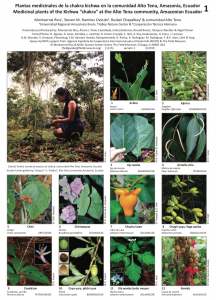
Montserrat Rios, Steven M. Ramírez Oviedo, Rusbel Chapalbay; comunidad Alto Tena Universidad Regional Amazónica Ikiam, Valley Nature Center; Cooperación Técnica Alemana
Producido por/Produced by: Montserrat Rios, Álvaro J. Pérez Castañeda, Erika Zambrano, Ronald Rivera, Tatzyana Wachter & Nigel Pitman.
Fotos/Photos: R. Aguilar, A. Arias, Ashitaka, L. Catchick, R. Foster, Freepik, S. Holt, A. Kay, Kowloonese, H. Kress, J. Lazcano,
O.M. Montiel, A. Orejuela, Plantsmap, S.M. Ramírez Oviedo, Rarepalmseeds, R. Rivera, D. Rodriguez, M. Rodriguez, F., K. Starr, Uleli, Yang.
Apoyo de/With support from: Agencia Española de Cooperación Internacional para el Desarrollo (AECID); The Field Museum
© Montserrat Rios & Keller Science Action Center, The Field Museum, Chicago, IL 60605 USA
[fieldguides@fieldmuseum.org][1115] versión 1 3/2019
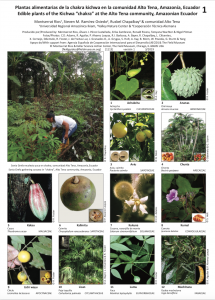
Montserrat Rios, Steven M. Ramírez Oviedo, Rusbel Chapalbay & comunidad Alto Tena Universidad Regional Amazónica Ikiam, Valley Nature Center & Cooperación Técnica Alemana.
Producido por/Produced by: Montserrat Rios, Álvaro J. Pérez Castañeda, Erika Zambrano, Ronald Rivera, Tatzyana Wachter & Nigel Pitman.
Fotos/Photos: C.D. Adams, R. Aguilar, P. Alvarez Loayza, R.I. Barbosa, A. Bayer, R. Chapalbay, L. Cifuentes, X. Cornejo, Ddemelo, R. Foster, J. de Freitas Luz, J. Granados O., A. Grygus, S. Holt, A. Kay, B. Mom, W. Poveda, G. Sturm & Yang.
Apoyo de/With support from: Agencia Española de Cooperación Internacional para el Desarrollo (AECID) & The Field Museum.
© Montserrat Rios & Keller Science Action Center, The Field Museum, Chicago, IL 60605 USA
[fieldguides@fieldmuseum.org][1113] versión 1 3/2019
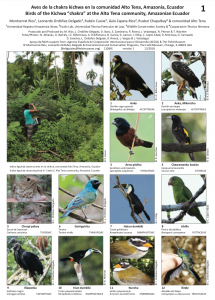
Montserrat Rios, Leonardo Ordóñez-Delgado, Rubén Cueva, Galo Zapata-Ríos, Rusbel Chapalbay; comunidad Alto Tena 1Universidad Regional Amazónica Ikiam; EcoSs-Lab, Universidad Técnica Particular de Loja; Wildlife Conservation Society; Cooperación Técnica Alemana.
Producido por/Produced by: M. Rios, L. Ordóñez-Delgado, D. Stotz, E. Zambrano, R. Rivera, J. Velasteguí, N. Pitman & T. Wachter
Fotos/Photos: N. Athanas, G. Bartley, J.C. Billonneau, A. D’Affonseca, B. García, D. Janson, J. Killip, C. López Abad, D. Montoya, O. Samwald, D. Sanches, L. Ordóñez-Delgado, R. Rivera, L. Vargas, J. Velasteguí.
Apoyo de/With support from: Agencia Española de Cooperación Internacional para el Desarrollo (AECID); The Field Museum.
© Montserrat Rios, Leonardo Ordóñez-Delgado, Environmental and Conservation Programs, The Field Museum, Chicago, IL 60605 USA
[fieldguides@fieldmuseum.org] [1084] versión 1 12/2018
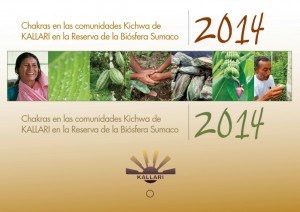
In the Amazonia of Ecuador, the families associated with KALLARI grow their plants one half to three hectares plots. In kichwa these fields are called “chakras”, and are known to contain high biodiversity. The management of these “chakras” combines ancestral wisdom of the Kichwa people with the lunar phase calendar for sowing, harvesting, and pruning. The cultural value of the “chakra” is reflected in daily family life, as it is when traditional practices are transmitted from one generation to the next with experiences, secrets, and life lessons.
Lehmann, S., M. Rios y Asociación KALLARI. 2014. Chakras en las comunidades Kichwa de KALLARI en la Reserva de la Biósfera Sumaco. Calendario 2014. Kallari, GEO schützt den Regenwald e.V. y GIZ. Quito.30 pp.
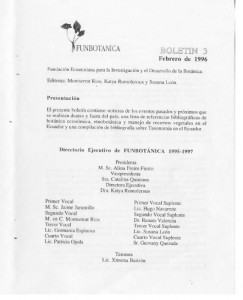
Bulletin 3 by FUNBOTANICA presents two articles. The first article is a scientific research made by Montserrat Rios and Henrik Borgtoft Pedersen which compiles 538 publications relating to useful plants in Ecuador; additionally, it mentions the libraries at Quito which hold information on plant biology. The second article compiles bibliography on taxonomical studies in the country.
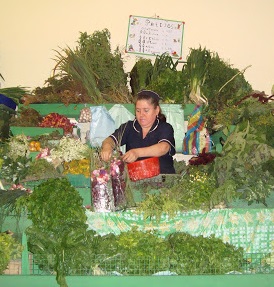
The traditional markets in southern Ecuador and within the Andean region are especially important for plant resource trading among local people, even since before Spanish colonization. These strategic spaces persist for the traditional medicine cultural value reflected in the higher consumption of medicinal plants. The purpose of this study includes the following: 1) to create a novel list of medicinal plants sold at 33 traditional markets; 2) to establish medicinal plant use agreement amongst vendors with the Factor of Informant Consensus (FIC); and 3) to determine the most sold medicinal plant species using the Fidelity Level (FL).
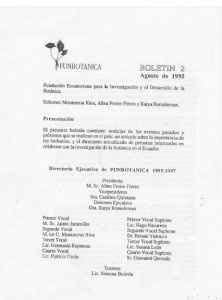
Bulletin 2 by FUNBOTANICA contains two articles. The first article discusses the importance of herbaria in Ecuador, their history and mission. The second article is a directory of botanists with research links to Ecuador. For the “Flora of Ecuador” project, the national and foreign group of researchers is considered, who contribute with their knowledge in taxonomy and/or systematics of the groups they research.
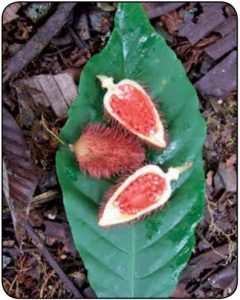
Waorani oral history in Ecuadorian Amazonia reveals that traditional ecological knowledge contributes to the understanding of the natural environment of this human group. When the Waorani interpret the landscape, they identify certain elements that stand out for their cultural and practical value, as these are products of past and present settlements.
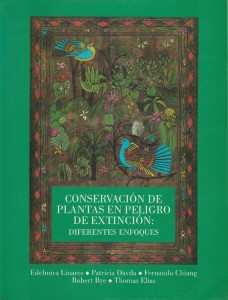
Ecuador is one of the richest countries of the world in terms of number of plant species per area. About half of the species grow in the mountain forests between 900 and 3,000 m. This diversity is due to the 26 ecosystems found in Ecuador. ENDESA (Empresa Nacional de Enchapados, S. A.) Forest Reserve is located in the subtropical zone of northwestern Pichincha Province and covers g5 hectares. The settlers of this Reserve use 101 plant species distributed in 82 genera and 46 families. The most important uses reported for these plants (number of taxa noted in parentheses) are: food (28), medicine for injuries and abscesses (20), for skin diseases (14), for hot and cold baths (13), for snake bites (13), and for insect stings (7), and construction (6).
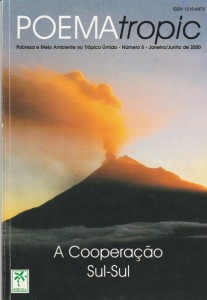
El objetivo central de este artículo es discutir la importancia que tienen los PFNM para los poblaciones tradicionales de la Amazonía, tanto a partir de varios estudios de caso que han sido reportados en la literatura, como de observaciones dilectas realizadas en varias localidades de la región amazónica ecuatoriana.
Amazonia Brasileira
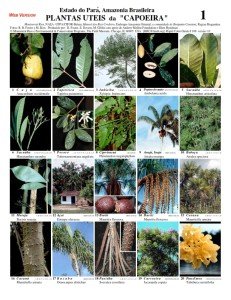
Investigación: Montserrat Rios, NAEA -UFPA/CIFOR-Belém; Manoel dos Reis Cordeiro, Embrapa-Amazônia Oriental; e comunidade de Benjamin Constant, Regiao Bragantina, Amazônia Brasileira.
Fotos: R. B. Foster y M. Rios. Produzido por: R. Foster, E. Davion, M. Giblin com apoio de Andrew Mellon Foundation e Ellen Hyndman.
Producido por: Montserrat Rios and “Environmental and Conservation Programs, The Field Museum”, Chicago, IL 60605 USA. [RRC@fmnh.org]
Rapid Color Guide # 108 versão 1.0
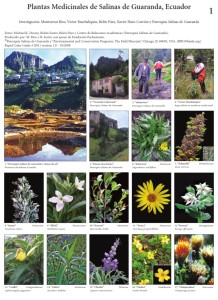
Investigación: Montserrat Rios, Víctor Yanchaliquin, Belén Páez, Xavier Haro-Carrión y Parroquia Salinas de Guaranda.
Fotos: Michael K. Dorsey, Robin Foster, Belén Páez y Centro de Relaciones Académicas (Parroquia Salinas de Guaranda).
Producido por: M. Rios y R. Foster con apoyo de Fundación Pachamama.
©Parroquia Salinas de Guaranda y “Environmental and Conservation Programs, The Field Museum”, Chicago, IL 60605, USA. [RRC@fmnh.org]
Rapid Color Guide # X011 versión 1.0 – 10/2008

In the rain forests in eastern Ecuador (Amazonia), a considerable number of indigenous societies still rely on plant gathering, hunting,and fishing. Our aims have been to foster cultivation of indigenous useful plants among these societies to help improve their economy, to preserve knowledge about and germplasm of some of their important useful plants, and to help strengthen their cultural identity.
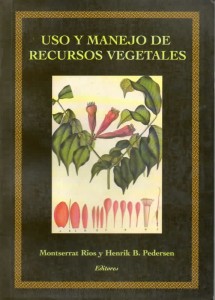
The aim of this research was to evaluate the importance of plants in the diet of the Ahuano community which is made up of Kichwa Indians and “mestizo” settlers. Located in the upper Río Napo in the Ecuadorian Amazonia. The patterns of variation of the diet were determined through the use of non-cultivated food plants, their cultural importance and their relationship with the process of sociocultural changes. A total of 94 species, 1 hybrid, and 4 clones belonging to 74 genus and 44 families were recorded. The non-cultivated plants (wild, protected, and tolerated) have more importance for the Kichwa population than for the “mestizo” settlers; however, due to social and economic pressure the Indian sector of the population is showing a tendency not to utilize these plant resources. This research was compared to other similar studies in order to determine how ecological, social and cultural changes affect societies that subsist on plant resources in their natural environment.
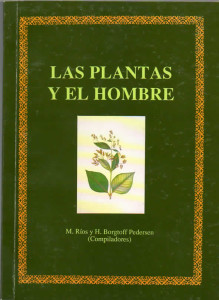
The main objective of this study was to identify the plants used by the inhabitants of the ENDESA reserve and the settlement Álvaro Pérez Intriago. This area is located at Km 113 on üe road Quito-Puerto Quito in the northwest of Pichincha province. The studied area is composed of a primary tropical rain forest covering 85 hectares and its surroundings. These include secondary forest, cultivated and reforested areas. Ethnographically, the area is defined as a disperse community with constant immigration and emigration. There are two types of colonists: those of permanent residence being the minority and, those in transit, looking for occasional jobs. The former use relatively more local plants, the latter contribute to the ethnobotany of the area by introducing plans from other locations of the country.